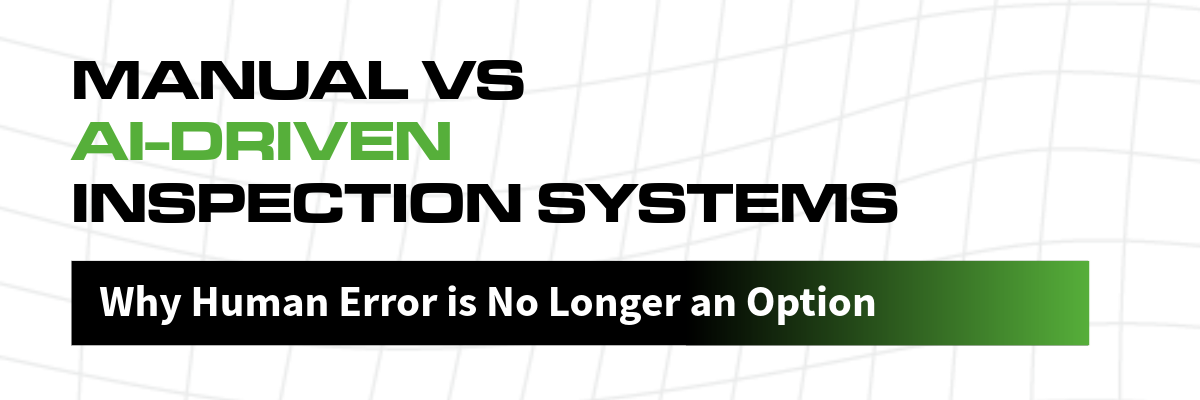As manufacturing lines accelerate and product complexity grows, AI-driven inspection is rapidly replacing traditional quality control methods. For decades, manual inspection has been the default approach of teams of operators visually checking for surface defects, missing components, or alignment errors. But in today’s high-speed, high-precision environment, the margin for human error has become too costly to ignore.
The Pitfalls of Manual Inspection
Manual inspection relies heavily on human consistency, attention, and experience. However, even the most skilled inspectors are limited by fatigue, bias, and subjectivity. Studies show that human inspectors can miss up to 20-30% of defects, particularly in repetitive, fast-paced workflows.
Familiar challenges with manual inspection include:
- Inconsistency across shifts or personnel
- Reduced performance during long shifts
- Difficulty identifying subtle or microscopic defects
- High training costs and turnover among inspection teams
In sectors like electronics, aerospace, or pharmaceuticals, where quality standards are non-negotiable, such gaps are unacceptable.
What Makes AI-Driven Inspection Superior?
AI-driven inspection systems, such as PIQuE, transform quality control into a scalable, precise, and repeatable process. Using advanced machine vision and adaptive learning, these systems can identify defects—scratches, dents, missing components, misprints, or alignment errors—faster and more accurately than the human eye.
PIQuE combines 3D laser triangulation with deep learning models to perform 360-degree full-coverage inspections. It eliminates the guesswork and inconsistency that plague manual methods. Once deployed, PIQuE begins working immediately with its pre-trained models, and over time, it improves by learning from every inspection it performs.
Speed and Scalability
Unlike human inspectors, AI systems do not tire, slow down, or require breaks. PIQuE delivers real-time inspection results at production speeds: no slowdown, no compromises. As production scales, the system remains just as effective, inspecting thousands of parts with the same precision and consistency.
This scalability is crucial for high-throughput environments. Whether you are producing 1,000 units per day or 100,000, AI inspection ensures quality standards remain intact at every level.
Adaptive Learning: Smarter Every Shift
One of the standout features of AI-driven systems like PIQuE is adaptive learning. As the system is exposed to more products and defect types, its detection models become increasingly refined. It learns from false positives, adjusts to new surface variations, and accommodates changes in lighting or material; all automatically.
For example, if a new batch of products has a subtle variation in texture or color, PIQuE can recalibrate without requiring lengthy reprogramming. This level of intelligence is simply not achievable with a human workforce alone.
Eliminating the Human Error Variable
The shift to AI inspection is not about replacing people; it is about eliminating preventable mistakes and reallocating human talent to more strategic roles. Quality assurance teams can now focus on analyzing data, improving processes, and ensuring compliance, rather than manually inspecting each unit.
By removing human error from the equation, manufacturers benefit from:
- Improved defect detection accuracy
- Lower false reject rates
- Fewer recalls and warranty claims
- Higher customer satisfaction
From Risk to Resilience
In industries with tight regulatory oversight or razor-thin margins, one mistake can lead to fines, lost contracts, or reputational damage. AI-driven inspection provides a layer of resilience that protects your brand and bottom line. With real-time monitoring, detailed analytics, and cloud-based traceability, systems like PIQuE ensure nothing slips through the cracks.
Future-Proof Your Quality Control
In an era where precision and speed define competitiveness, clinging to manual inspection is a risk no manufacturer can afford. AI-driven inspection offers a smarter, more reliable alternative; one that adapts, scales, and learns from your operations.
Now is the time to move beyond the limits of human vision. With solutions like PIQuE, you can ensure consistent quality while freeing your workforce to focus on innovation and growth.

